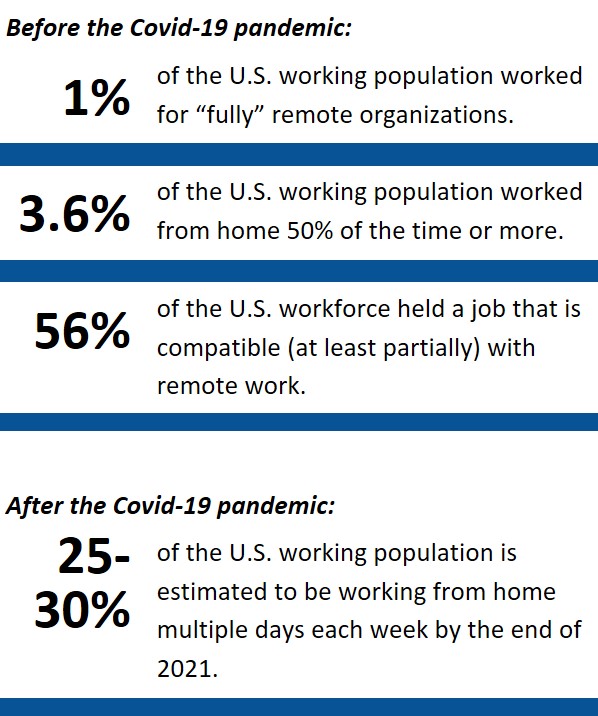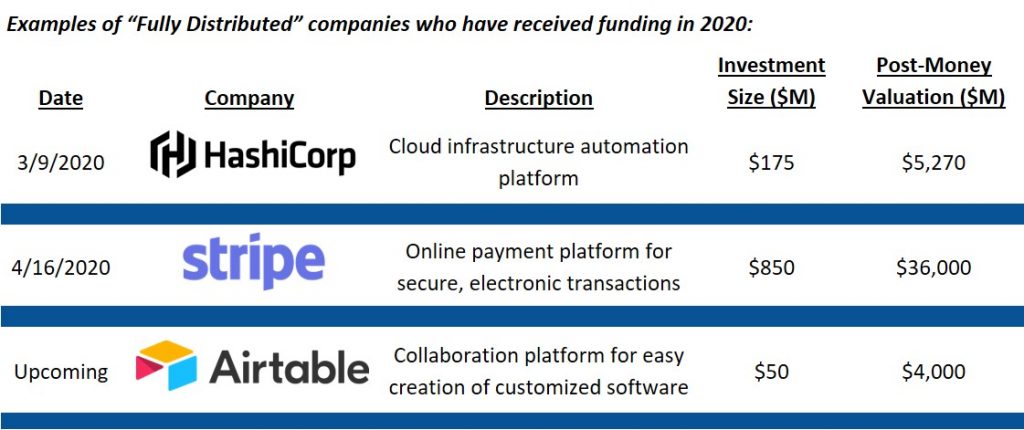Part 1: The Strengths & Opportunities
At the onset of the COVID-19 crisis, “distributed workforces” (fully remote organizations without central offices) were able to more quickly adapt to stay-at-home measures, keeping expenses low relative to their central location-based peers. As pandemic recovery continues, these characteristics could support higher valuations, help attract increased equity investment and create conditions for distributed businesses to become key innovators over the next economic cycle. Could the COVID-19 pandemic be setting the stage for a new era of fully remote organizations that serve as a model for cost-effective, flexible growth over the next decade? In this article, Carleton McKenna discusses how the institutionalization of distributed organizations may have significant economic and social impacts as businesses adopt new approaches to work, and as employees and capital become less tied to specific geographic locations.
The pandemic could catalyze increased valuations and investment in distributed businesses.
The fully distributed model has been debated at great length among business owners and investors. While startups often begin in a founder’s home with remote and part-time help, investors can question how well a business can find its footing and grow—especially in its early days—without close, personal collaboration among employees. Similarly, as organizations scale, the distributed model is often viewed as an impediment to that growth, which has historically made it harder for companies to raise money. However, the COVID-19 pandemic is shining a spotlight on remote work in new ways that is likely to promote acceptance among skeptics.
Fully remote business are suddenly in vogue, as they:
- have been able to weather the downturn more easily;
- did not have to force a transition to the remote format;
- did not have high, ongoing facilities costs relating to unused office or retail space; and
- are well-positioned to continue hiring with a favorable non-geographic labor market as more companies lay off employees.
This could drive investors to place higher value on remote work models—improving the ability for distributed organizations to attract capital and grow—and ultimately lead to a new class of fully distributed organizations that emerge from the crisis in a relatively stronger position.

Traditionally, remote work has been predominately viewed as a flexible and convenient option for employees who need to work remotely for a period of time due to some medical, personal, family or geographical reason. However, strategically deciding to be a fully distributed organization is a much different scenario. In this case, the benefits of being fully remote can outweigh the alternatives by including: (i) cost savings from not having central facilities; (ii) improved employee morale by enabling ultimate flexibility and the ability to live in less crowded and/or less expensive locations; and (iii) the ability to hire from a global talent pool without having to compete for candidates in dense, often industry-centric cities. These advantages continue to call to business owners as organizations seek ways to reduce costs and improve productivity during these disrupted economic times.
Demographic trends are clearly supportive of distributed businesses. As millennials (approx. 50% of the global workforce in 2020) start families and prioritize physical space and quality of life, their preference to live in dense urban locations will likely diminish. Additionally, post-pandemic fears of future virus outbreaks and growing environmental efforts to reduce carbon footprints are both trends supporting remote work. Employees who historically hesitated relocating to smaller towns in fear of finding themselves unemployed will no longer face this risk with a more robust and distributed employer base.
Despite the cost and recruiting advantages, few employers have been able to make the convincing argument that remote work actually results in a better product. However, the COVID-19 pandemic has lingered, forcing many companies became fully distributed for a couple months. The unplanned remote work prioritized the use and development of remote ecosystems and this could lead to an era of digital disruption yielding higher levels of productivity.
Forced adoption and integration of remote-work capabilities during the pandemic has already demonstrated the strength of existing digital and ecommerce infrastructure, as delivery networks, social networks, digital entertainment and other services have continued largely uninterrupted. While some “last mile” connectivity and capacity issues have created practical concerns, network providers are continuing to make improvements. Over the next 5-10 years, we can expect advances in 5G wireless technology, improved WiFi, IoT and edge networking to further strengthen distributed communications—opening the door for new digital products and services, and enabling more work to be completed virtually.
Source: Pitchbook, PwC
A new era of increased remote work could have social and economic implications.
Removal of geographic constraints on business formation and job location could drive the de-urbanization of both labor and capital, for companies able to take advantage of remote work. In particular, these trends are more likely to drive change in large cities, where skilled labor and investment capital have traditionally been concentrated. As employees move to more rural locations, they will take salaries with them—decreasing the respective city’s tax base and causing a potential decline in economic activity. Thus, rural areas should become the beneficiaries of this trend, as the inflow of employed workers drives economic activity and attracts investment capital. Furthermore, there has been substantial research on the positive impacts of telework on the environment. A reduction in lengthy commutes, traffic and congestion in cities and related travel would undoubtedly help reduce carbon footprints.
At the onset of the COVID-19 pandemic, it was estimated that up to 56% of U.S. jobs could become at least partially remote and 37% of U.S. jobs could feasibly become “fully” remote (note: total U.S. workforce estimate of 156 million in 2018). While not all organizations will permanently adopt a virtual work model post-pandemic, and not all new remote jobs will result in employees moving to the countryside, the scale of these numbers is significant. Even a nominal 5% shift to virtual workplaces (an estimated 7.8 million people) would have meaningful, long-term implications to our economy.
Could there be negative ramifications to a mass movement from on-premise to distributed work? Carleton McKenna will provide our perspective on the challenges associated with the megatrend of fully distributed workforces in Part 2 of this series.

